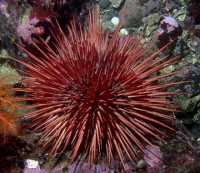
24 Jun Gene Expression Helps Explain How the Red Sea Urchin Can Defy Aging
MedicalResearch.com Interview with:
Andrea Bodnar, Ph.D., Science Director
Gloucester Marine Genomics Institute (GMGI)
MedicalResearch.com: What is the background for this study? How does gene expression differ in the red sea urchin from humans? Why is this animal not susceptible to age-related deterioration?
Response: The red sea urchin is one of the earth’s longest-lived animals, living for more than 100 years without showing signs of aging. These animals grow and reproduce throughout their lives and show no increase in mortality rate or incidence of disease with age. This includes no reported cases of neoplastic disease, like cancer.
To begin to understand the cellular mechanisms underpinning this extraordinary life history this study investigated gene expression patterns in the tissues of young and old red sea urchins.
MedicalResearch.com: What are the main findings?

Dr. Bodnar
Response: The results revealed a unique pattern of gene expression in nerve tissue that was distinctly different to that seen in the aging nervous system of humans and other animals. With age, the red sea urchin shows increased expression of genes involved in nerve function, neuroprotection and autophagy, a process that prevents the accumulation of damaged cellular components and protein aggregates, which are characteristic of neurodegenerative diseases in humans. This unique gene expression profile suggests preservation of the nervous system with age in these long-lived animals.
MedicalResearch.com: What should readers take away from your report?
Response: By studying long-lived animals with slow or negligible aging, we can begin to understand strategies for long-term maintenance of tissue function and healthy aging. The close genetic relationship between sea urchins and humans makes them an ideal model to identify key genes and cellular pathways involved in negligible aging and resistance to age-related diseases. Ultimately, it is hoped that what we learn from sea urchins could translate into preventative or therapeutic strategies for age-related degenerative diseases in humans.
MedicalResearch.com: What recommendations do you have for future research as a result of this work?

Red Sea Urchin
Wikipedia image
Response: Gene expression analysis on whole tissues is just the first step in understanding the mystery of how these animals evade the ravages of time. Single-cell transcriptomics will offer a more detailed understanding of changes in different cell types, and functional studies will determine if the observed changes in gene expression act to preserve tissue function and mitigate aging in these long-lived animals.
MedicalResearch.com: Is there anything else you would like to add?
Response: The authors are grateful for funding from the Dusky Fund of the Essex County Community Foundation, and a Bermuda Charitable Trust that supported this work.
Citation:
Polinski, J.M., Kron, N., Smith, D.R. et al. Unique age-related transcriptional signature in the nervous system of the long-lived red sea urchin Mesocentrotus franciscanus. Sci Rep 10, 9182 (2020). https://doi.org/10.1038/s41598-020-66052-3
[subscribe]
[last-modified]
The information on MedicalResearch.com is provided for educational purposes only, and is in no way intended to diagnose, cure, or treat any medical or other condition. Always seek the advice of your physician or other qualified health and ask your doctor any questions you may have regarding a medical condition. In addition to all other limitations and disclaimers in this agreement, service provider and its third party providers disclaim any liability or loss in connection with the content provided on this website.
Last Updated on June 24, 2020 by Marie Benz MD FAAD

